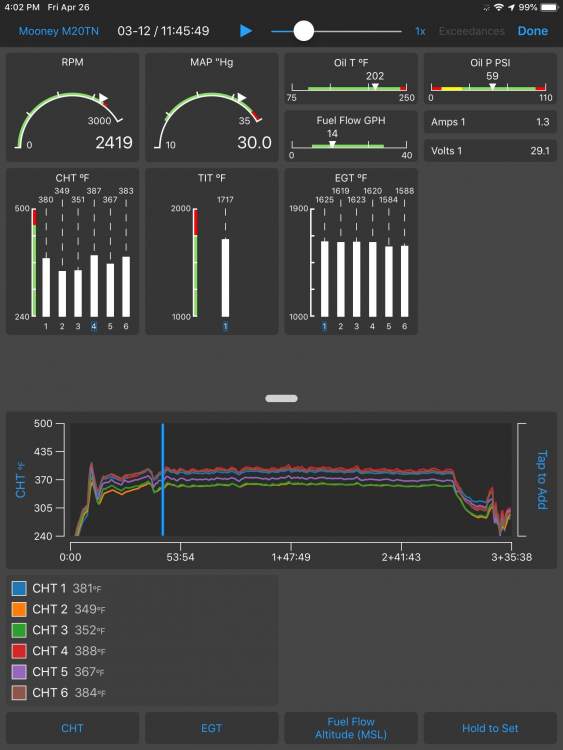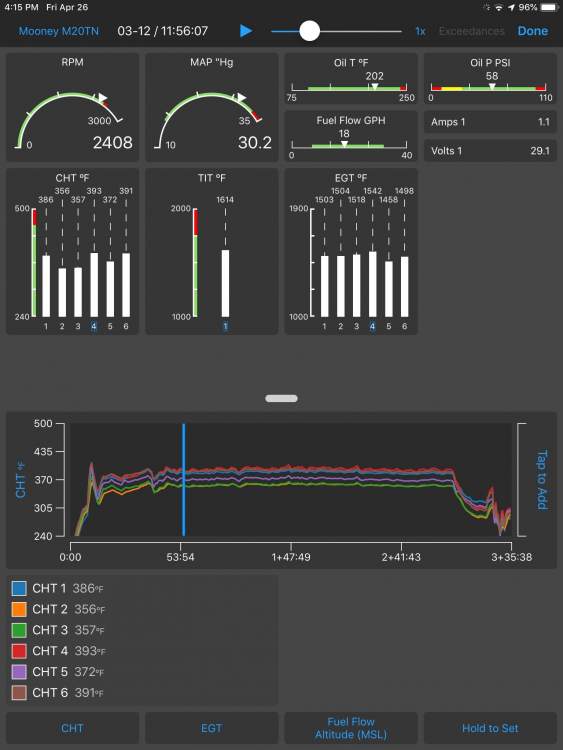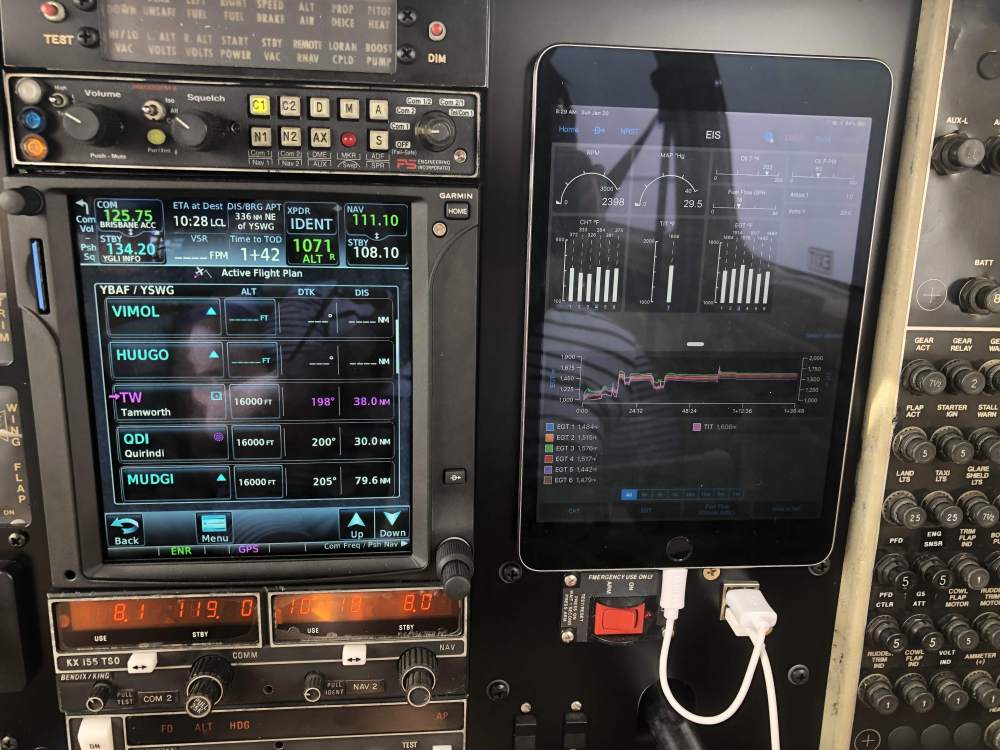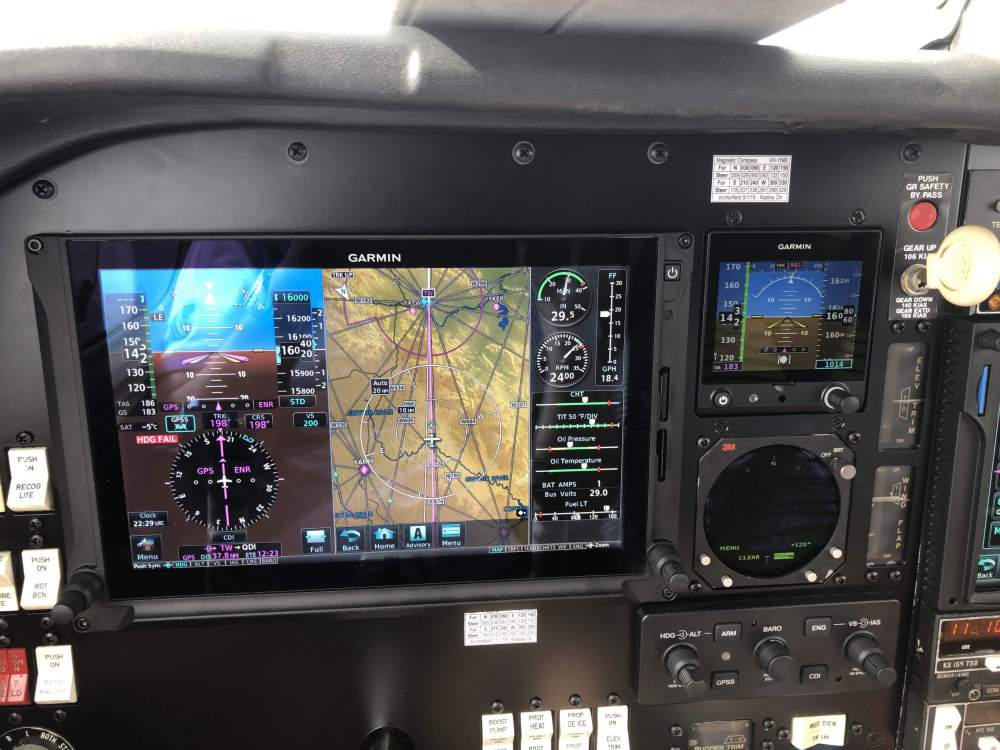-
Posts
67 -
Joined
-
Last visited
Content Type
Profiles
Forums
Blogs
Gallery
Downloads
Media Demo
Events
Everything posted by Steve Skinner
-
These are great numbers. I certainly understand the link between ignition timing and CHT - been there also. I find at 34-24 and above F170 I’m looking at closing in on 400. I need to reduce climb to below 500 ft/m to keep below 400. My airplane was rebaffled 10 yrs ago and still in perfect condition. I do live in Queensland Australia where only in the dead of winter (or thunderstorms) do we find OAT much less than zero. Sent from my iPhone using Tapatalk
-
I see your numbers are for a pretty warm day. i cruise climb at 34 24 130 knots which usually yields 900 - 600 ft/min as climb progresses. full throttle climbs would yield the numbers suggested on such a hot day. Obviously you have a similar personal limit of cht. Mine is 400. i just adjust IAS to accommodate. Sent from my iPhone using Tapatalk
-

Help Analyze Cruise Numbers - New Bravo Owner
Steve Skinner replied to irishpilot's topic in Mooney Bravo Owners
I fly between 10k and FL19 dependent on wind and distance. Almost always 100 deg ROP is 1600 TIT. Head wind 31/2400 (20g/hr) tail wind 30/2200 (18 g/hr) If I can’t maintain less than 200 deg oil temp and cyl less than 400 I’ll first trail cowl flaps then add fuel or reduce mp. It has to be very hot OAT to do more than trail flaps. 1st engine went to TBO with good compressions. 2nd life at 1/2 life with no issues (except turbo replacement @ 1/2 life) To add always cruise climb at 34/24 or 35/25 and decent at 28/20 peak tit. It doesn’t take much of a timing issue to increase temps dramatically in a Bravo. I’d be getting it checked by a different technician. Sent from my iPhone using Tapatalk -

Help Analyze Cruise Numbers - New Bravo Owner
Steve Skinner replied to irishpilot's topic in Mooney Bravo Owners
Hi I’m a Bravo owner with 1400 hrs Bravo experience. To my mind at those numbers and low altitude you should be quite a bit cooler egt’s - 360-370. So either timing is out or cooling shroud needs some work. I would be happier increasing to 100 rop and increasing Tit to 1600 to get the same fuel flow. 0-50 Rop is known as the red box and allegedly bad for your engine although that said less than 75% power any setting should be ok. if you were trying to run these numbers with your engine at 18000’ your oil temp and cht would be off the chart as there is less cooling there. Your oil temp should never be that high st such a low altitude- I would suggest get a good A&P to re cowl your engine and check the timing -
1750 tit max on the M model but I have a personal max of 1600 in cruise but fly peak on decent 29” 2000 which often yields 1650 or better. i agree warning on Jpi is set too high. Climb out for me is 35 2500 full rich gives me about 1550 tit and 24-25 gph. cruise at 31 2400 or 31 2200 wind dependent 100 rop usually yields around 1600 tit. And 18 gph.
-
Just to add if you’re not bored yet The M model is 28” 2000 700’ /min and peak tit giving about 12g/h at 170 knots indicated. I’ll hit the speed brakes just before entering potentially bumpy cloud. Lower again once thru and hold amp & rpm till pattern. Sent from my iPhone using Tapatalk
-

When to overhaul the turbocharger?
Steve Skinner replied to Rick Junkin's topic in Mooney Bravo Owners
My last turbo went 1300 hrs so I think Ive been ripped off. I responded on this topic because of the original question asked. Ive always added pireps where possible to increase the knowledge of others that might find themselves in this position. I agree in hindsight I should have landed for at least a review of the engine.- 39 replies
-
- 1
-

-
- turbo iroc
- turbo iran
-
(and 1 more)
Tagged with:
-

When to overhaul the turbocharger?
Steve Skinner replied to Rick Junkin's topic in Mooney Bravo Owners
Mitigating circumstances are: I generally climb at 35” 2500 and saw no issues till I glanced at the MP and it was at 34” and looked to be dropping as I climbed further. It was only sudden as in I didn’t see it happen. I’d had issues with the density controller and assumed that was the issue but a small exhaust gas leak was in the back of my mind. At 17000 I was maintaining 35” with normal throttle so I elected to continue at 30” 2200 with no issues. The turbo failure at less than 800 hrs is well before a half life rebuild. In hindsight I agree with you knowing what actually occurred I should have been on the ground sooner rather than continuing.- 39 replies
-
- turbo iroc
- turbo iran
-
(and 1 more)
Tagged with:
-

When to overhaul the turbocharger?
Steve Skinner replied to Rick Junkin's topic in Mooney Bravo Owners
So now at 800 hrs I require a turbo Repair/Replacement. Last flight I had a sudden drop in manifold pressure. Going thru 18000 I dropped an inch or so and descended to 17000 for the balance of the flight On inspection the center of the turbo let go. So once off you can twist the hot and cold side. There was exhaust gas everywhere. Luckily all contained Sent from my iPhone using Tapatalk- 39 replies
-
- turbo iroc
- turbo iran
-
(and 1 more)
Tagged with:
-
WOT on take off is 27 gph. Cruise climb 34/2400 is 24 gph Shadin and TXI Eis match Sent from my iPad using Tapatalk
-
This looks terrific. I bet it flys like an Airline. Garmin should reimburse you for an all Garmin panel. (Except for the engine monitor) Congratulations Don Sent from my iPad using Tapatalk
-
Morning, This data is in the pilots log of Garmin Pilot when you have a G500TXI with EIS and a Fs510. It logs every flight for logbook purposes including route alt and engine data. Also have a permanent IPad mini set up on co-pilot side that depicts the eis data page on the txi. Sent from my iPad using Tapatalk
-
I thought your cht’s were in the ballpark. This Bravo has 1100 hrs. Since zero timed. Last engine went to TBO. I've got gami’s that probably should be rebalanced but the attachment shows how close the egt’s are having just reached peak and on the way back to 100 rop. Generally my no.4 is the hottest at cruise also has the highest egt by a small amount. Second attachment is cruise. Second shot if I can at
-
It won’t stop at 8. Some engines throw oil on the belly over 9 quarts, mine doesn’t. The logic of not going below 8 is about volume available to cool the engine. The Bravo oil has a much larger task than most due to its requirement to cool exhaust valves. So between that and the turbo you get a 25 hr mandated oil change. Personally I’d always top up at 8.
-
Agree with this (currently Myoko Japan) I will always lower speed brakes once gear is down. I use them on decent approaching cloud. Use them at the FAF to get to gear speed. Use them when given a “reach alt by” (9000 by bla bla) Definitely don’t use them at night near a thunderstorm at 19000’ to slow due to severe turbulence -they will ice up and won’t retract. Ask me how I know - Atc held me there until I “required lower” There were heavy jets holding all over the place due to the storms overhead their airport. I was just a bystander traversing their airspace. It was 75f on the ground and no ice remaining for landing. Sent from my iPhone using Tapatalk
-
I start at 10 liters/pints By about 10 hrs I’m at 8.5 I add a pint and that gets me 25 hrs. Apparently I run my engine at higher power levels than some at 31/2400 1600 tit (100rop) = 19.5-20g/hr the last engine made it to TBO without issue and still had compressions around > 73/80
-
Set at installation. The avionics guy came for a test flight to confirm he had guessed correctly he had G5 and Txi showed level flight at cruise Sent from my iPad using Tapatalk
-
Yes. However the issues with thE AHRS are a Garmin problem. The magnamometer is still anybody’s guess Sent from my iPad using Tapatalk
-
So 9 hours this week on the new new panel. Have discovered that the “heading fail” starts not long after raising the gear and goes away when I lower the gear. So may have to move the magnamometer as it’s obviously magnetic interference. Had Ahrs fail inbound to Tamworth on the return from Melbourne. Message was “lost barometric altitude” So it took what seemed like 10 seconds to figure out that the autopilot wasn’t doing what it was supposed to do and that I had a G5 with baro alt on it. The Txi screen showed gps altitude above the X’s which was all over the place. I took a screen shot and sent it to the avionics guy. He said the fail certainly got Garmin’s attention Was good practice to understand what was going on. Take off auto pilot and fly by the G5. I think I still had wings level with auto pilot on but saw that VS and ALTc had been replaced by the 2 big red X’s. Not having a clue what altitude you are at in controlled airspace made the heart pump for those few seconds before mentally changing to the G5. I had been flying manually earlier in the flight with the auto pilot breaker pulled as Garmin were trouble shooting the magamometer. Sent from my iPad using Tapatalk
-
Mine does not. However I got the tech to squeeze in a tit depiction into the strip so I guess anything is possible. I would have thought it only important to a shared aircraft. You know the numbers that you fly. Sent from my iPhone using Tapatalk
-
No. The EIS unit is an add on the the TXI to replace engine gauges and the TXI just bluetooth it to the iPad via 750. Those that retain their primary or have the JPI replacement don’t need to spend the $3-5k for the EIS unit Sent from my iPhone using Tapatalk
-
I agree. I think we are used to “numbers” which seem to make us more comfortable. I mentioned in an earlier post that the EIS page didn’t seem as important as the old gauges but of course it is. I kept looking over at the iPad to pick up the numbers. Sent from my iPhone using Tapatalk
-
New panel in flight. ignore egt difference (no 3 plug, rh mag failed in flight) Ignore “heading fail” (work in progress) new iPad on pax side with live EIS feed
-
Panel whilst flying Ignore “Heading Fail”, ( still trouble shooting) ignore high EGT on no 3 (looks like a failed plug on right mag) iPad on pax side showing EIS feed TAS about 190 at 18 gph running a bit richer than normal due to Plug problem. Sent from my iPhone using Tapatalk
-
We’re down to either interference from the auto pilot or alternators He degaussed the whole area around the magnetometer so he’s hoping that could be the issue. It didn’t fail with the lights on and I had every light on. He’s allegedly fixed the fuel flow. So with 5.5hrs and 11 approaches I’m getting there. I’m putting an iPad mini in the spare space on pax panel which can be used for EIS or watching a movie. 8 hours next week then I’ll turn on SVT trial. Not much point at 18000’ to and from Melbourne. Sent from my iPad using Tapatalk





